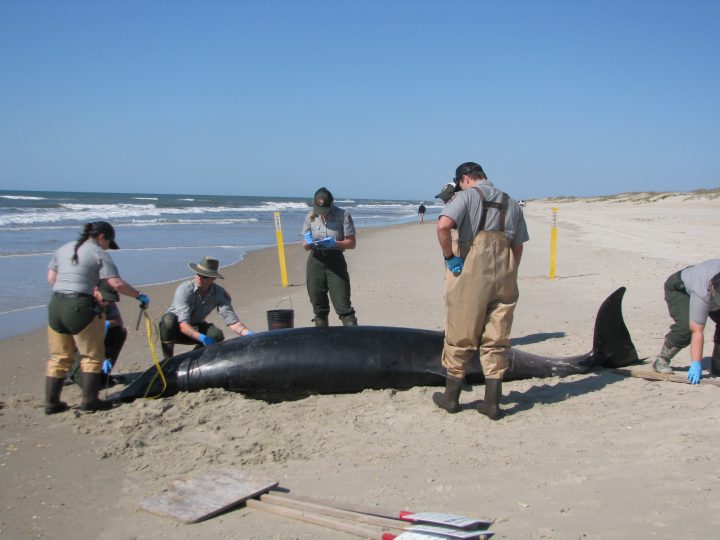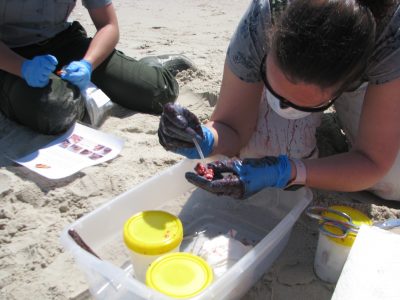
OCRACOKE ISLAND – It was a beautiful spring day, two days before the opening of the Ocracoke Fishing Tournament.
Lisa Loos, who had driven with her husband from their home in Winston-Salem for the tournament, was fishing on the beach when she saw something in the surf.
Supporter Spotlight
“We thought we saw dolphins playing off the sand bar and I started walking towards them,” she said. “Then I thought it was a shark because a fin was sticking up. Then we realized it was a whale. As it got close to shore, it started to thrash since the water was not deep enough.”

I learned about it the following morning. Peter Vankevich, co-publisher of the Ocracoke Observer, local artist Susse Wright and I were driving up the beach to see what birds were there. Peter got a call from National Park Service biologist Joslyn Wright, saying that there was a stranded whale near Ramp 67 and a team was preparing to do a necropsy, as an animal autopsy is called. We decided to drive over and learn more.
It was not hard to spot the group of people standing around the large black form lying near the water’s edge. I spoke with Lisa, who said that she and her fellow fisherfolk had called the National Park Service immediately after seeing it. They had tried to push the whale back out as it struggled against the waves, but it was too heavy. A park service ranger arrived in about 20 minutes. The whale died soon after it stranded.
It was a beaked whale, we were told by Wayne Justice, a team member of the North Carolina Marine Mammal Stranding Network, who had come from the North Carolina Aquarium at Pine Knoll Shores to help the park service with the necropsy.
Beaked whales are members of the family Ziphiidae that includes 22 species, 11 of which are found in North America. They live far offshore, diving far into the depths of the ocean. Among air-breathing animals they are the most extreme divers, sometimes reaching depths of 3,000 feet and staying underwater for an hour or more. They are some of the least-known mammals, because of their deep-sea habitat, mysterious habits and apparently low numbers. Most are slender, medium-sized whales with a small head, a distinctive beak-like snout and a single blowhole. They can weigh up to 2.7 tons and reach about 24 feet in length. The body is compressed laterally, and the flippers and fluke are small and narrow with a dorsal fin situated well back along the body.
Supporter Spotlight
Most beaked whale species are very similar and difficult to tell apart. This one was originally thought to be a True’s beaked whale, but Paul Doshkov, a bio-technician and lead marine mammal response coordinator with the National Park Service stationed in Bodie Island, later identified it as a Gervais. Named for the French scientist who in the mid 1800s identified it as a new species, the Gervais beaked whale’s scientific name is Mesoplodon europaeus, and it is also known as the Antillean or Gulf Stream whale. It is found far offshore from Long Island, New York, to Trinidad, including the Gulf of Mexico, across to the English Channel, as well as off African and South American waters.
As we waited for all the team members to arrive, Justice explained that during the necropsy they would be searching for any signs of illness or injury that might have led to its ending up so close to shore and eventually dying on the beach.
“You just don’t see beached whales that are healthy,” he said. “There is usually a major illness or sickness that is already in place. The reality is that they are already too weak, and the currents push them to the beach.”
He added that, “while it is sad to see such a highly intelligent animal in a condition like this, it is an opportunity to learn more about them.”
Peter and Susse had to get back, but I decided to stay and watch the necropsy performed by National Park Service, North Carolina Aquarium and University of North Carolina researchers, many of whom had worked together at other strandings. I was given a paper and pen and asked to take notes.
The whale measured 14.5 feet and weighed 2,065 pounds. It was an adult male with no apparent injuries other than shallow abrasions from being tossed in the surf.
As they cut the skin away, the technicians pointed out the thick layer of blubber that during earlier times would have been cut up and melted down to produce oil for lanterns. Beaked whale blubber is unique from that of other whales in that it is composed almost entirely of lipids called wax esters.
The flesh of the whale was a rich, dark red color, derived from the high level of oxygen needed for long dives when the whale was unable to breathe. The organs were carefully removed and examined. The notes I recorded included an empty stomach, a light load of nematodes in the gastrointestinal tract, small masses in the pancreas and parasites in the liver.
One of the technicians used specialized surgical instruments to remove the ear bones from the whale’s head. They were to be sent to an institution in France for an acoustic trauma study. Sonar operations, such as are used by the Navy, can damage the ears of marine mammals, interfere with their ability to navigate, and cause them to lose their way and end up on distant beaches. There has been a correlation in the past between Navy sonar testing and beached beaked whales.

The cranial section of the vertebral column was removed and would go to University of North Carolina Wilmington for further study.
The team dispersed after the necropsy was completed, and a National Park Service bulldozer arrived to bury what remained of the carcass. I got a ride with park service biologist Joslyn Wright back to the village, where I began reading more about what I had seen.
Beaked whales have an average lifespan of 27 to 39 years. Their ability to dive to great depths is facilitated by a large spleen and liver, as well as the high oxygen content of the flesh. While diving, the heart slows and the blood flow changes.
They feed mostly on squid, according to necropsy studies, but also on fish, shrimp and some crustaceans found near the ocean floor. They find their food, it is believed, through echolocation and use a unique mechanism to suction it into their mouths. There are throat grooves that stretch and expand to move the food into the digestive tract. Because the stomach of this whale was empty, its diet could not be analyzed.
While considered toothed whales, the teeth of females do not develop outwardly but remain hidden in the gum tissue. The males have tusk-like teeth and in most species, there is only one set. It is believed that the purpose of the males’ teeth is not so much for eating as for sexual attraction, like antlers on deer. In Gervais beaked whales, the males’ front, lower teeth protrude.
While beaked whales live too far out at sea to have many interactions with human activity, studies show that they are increasingly threatened by plastic pollution, deep-sea fishing nets and a rising level of toxic chemicals in their blubber. Sonar testing used by the Navy and, should off-shore oil and gas drilling be approved, in fossil fuel exploration, are also of great concern. Test results to determine what led to this whale’s stranding and death are not yet completed.
To report a beached whale or other marine mammal contact the Cape Hatteras National Seashore Sea Turtle and Marine Mammal Stranding hotline at 252-216-6892.








